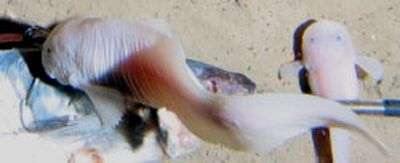March 5, 2014 report
Why marine fish don't go into the deeper blue

(Phys.org) —Fish appear to be absent from the ocean's greatest depths, the trenches from 8,400 to 11,000 m. A team told Proceedings of the National Academy of Sciences about this in a study titled "Marine fish may be biochemically constrained from inhabiting the deepest ocean depths."
Their study explains why you will not see marine fish inhabiting the deepest ocean depths. The fish are unlikely to survive in oceans deeper than about 8200 meters and the reason has to do with physiology. "We propose that the answer is the need for high levels of trimethylamine oxide (TMAO), common in many marine animals," said the study authors. TMAO is a powerful stabilizer in fish that counteracts the destabilization of proteins by pressure. The researchers observed that the deeper they went, the fish species appeared to have increasing amounts of TMAO. That impacts depth limits. "We know that if TMAO is too high, it makes proteins so stable they can't work," Paul Yancey a biology professor at Whitman College, Washington State and one of the study authors, told BBC News. Yancey said the myosin protein in muscle needs to flex for muscles to move, and too much TMAO would stop this happening.
The team sought their answers to depth limits in fish by looking at hadal snailfish, recovered from the bottom of the Kermedec Trench north of New Zealand. "This is by far the deepest fish we've caught and analyzed, and they have the highest levels of this TMAO molecule," Yancey said in the BBC report.
"By capturing the world's second-deepest known fish," the team wrote in their study," the hadal snailfish Notoliparis kermadecensis from 7,000 m, we find that they have the highest recorded TMAO contents, which, moreover, yield an extrapolated maximum for fish at about 8,200 m. This is previously unidentified evidence that biochemistry may constrain depth for a large taxonomic group."
Study authors are Paul Yancey, Mackenzie Gerringer, Jeffrey Drazen, Ashley Rowden, and Alan Jamieson. Author affiliations are Whitman College, Walla Walla, Washington, University of Hawaii, the National Institute of Water and Atmospheric Research, New Zealand; and University of Aberdeen, UK.
More information: PNAS DOI: 10.1073/pnas.1322003111
Abstract
No fish have been found in the deepest 25% of the ocean (8,400–11,000 m). This apparent absence has been attributed to hydrostatic pressure, although direct evidence is wanting because of the lack of deepest-living species to study. The common osmolyte trimethylamine N-oxide (TMAO) stabilizes proteins against pressure and increases with depth, going from 40 to 261 mmol/kg in teleost fishes from 0 to 4,850 m. TMAO accumulation with depth results in increasing internal osmolality (typically 350 mOsmol/kg in shallow species compared with seawater's 1,100 mOsmol/kg). Preliminary extrapolation of osmolalities of predicted isosmotic state at 8,000–8,500 m may indicate a possible physiological limit, as greater depths would require reversal of osmotic gradients and, thus, osmoregulatory systems. We tested this prediction by capturing five of the second-deepest known fish, the hadal snailfish (Notoliparis kermadecensis; Liparidae), from 7,000 m in the Kermadec Trench. We found their muscles to have a TMAO content of 386 ± 18 mmol/kg and osmolality of 991 ± 22 mOsmol/kg. These data fit previous extrapolations and, combined with new osmolalities from bathyal and abyssal fishes, predict isosmotic state at 8,200 m. This is previously unidentified evidence that biochemistry could constrain the depth of a large, complex taxonomic group.
via BBC: www.bbc.com/news/science-environment-26423203
Journal information: Proceedings of the National Academy of Sciences
© 2014 Phys.org


















